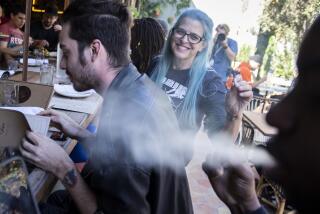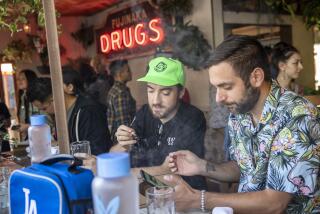Braude Sees Improved Chances for Motion to Ban Restaurant Smoking
- Share via
In his starched white chef’s hat and jacket, Pierre Pelech fretted over renewed talk about banning all cigarette smoking in restaurants in Los Angeles.
“It would be catastrophic for the restaurant business,” said Pelech, co-owner of Pierre’s restaurant in Los Feliz. “There would be a drop in business, and that would put people out of work.”
A raspy voice from the restaurant bar added: “I don’t mind cigarette smoke.” It came from hotel owner David Halliburton, who was breathing with the aid of an oxygen tank.
“I’m running around with an oxygen bottle, but I don’t think the City Council should tell a man how to run his business,” said Halliburton, who suffers from emphysema, which he blames in part on smoking.
Ratcheting up the debate once again on the rights of nonsmokers to breathe clean air and the rights of smokers to indulge in their habit, City Councilman Marvin Braude has introduced a motion to ban smoking from all restaurants and city government buildings.
It is the second time in a year that crusading anti-smoker Braude has authored such a bill in Los Angeles, where restaurants are already required to set aside nonsmoking sections.
In October, 1990, the City Council deadlocked 6 to 6 on the proposal, which needed eight votes to pass. Five of the council members who voted against it--Nate Holden, Michael Woo, Gloria Molina, Hal Bernson and John Ferraro--had received campaign contributions totaling $500 to $1,000 from the tobacco industry in recent years. Councilman Robert Farrell, who voted for the ban, received $500.
Records show that the tobacco industry donations to the mayor and council members between 1984 and 1990 totaled $13,150, including $3,900 to Mayor Tom Bradley.
The city of Beverly Hills imposed such a ban in 1987. But restaurant associations and the powerful tobacco lobby fought back, forcing amendments a few months later requiring restaurants there to allow smoking in 40% of dining areas.
But Braude--citing new medical reports showing that smoking and secondhand smoke kill 500,000 people a year--figures that this year he can beat opponents, including the 3,000-member California Restaurant Assn.
This time around, there are three new members on the council--all of whom said they intend to support the bill when it comes before the full council in January. Among them is Councilman Mike Hernandez, who said, “I’m a smoker, but we have to set a positive example for our children.”
In addition, 14 cities and two counties across the state have laws on the books to ban smoking entirely from restaurants, and the number of Californians who smoke has dropped to an all-time low of 20%.
“This time we will be more forceful and we will have the medical profession coming out in large numbers on our behalf,” Braude said. “I wouldn’t be surprised if I got 10 votes on the council.”
But political consultant Rudy Cole, executive director of a tobacco industry-funded coalition known as RSVP, Restaurants for a Sensible Voluntary Policy (on smoking), said his group plans to barrage council members with telephone calls and mailings warning that times are too tough for restaurants to be hit with what they consider an economic meat cleaver.
“Once council members (in favor of the ban) realize what the impact will be on the labor force,” Cole said, “they’ll change their minds.” A year ago, RSVP predicted that a smoking ban would cost the restaurant industry 3,300 jobs in Los Angeles.
Cole acknowledged that RSVP receives about 50% of its funding from the Tobacco Institute and tobacco companies, which “helps us do mailings and publicity.”
Cole, who also helped organize restaurants to fight the smoking ban in Beverly Hills, declined to disclose the amount the group intends to spend in Los Angeles to keep Braude from achieving his goal of making Los Angeles the first large city in the nation to ban smoking in restaurants entirely.
As part of the effort to derail Braude’s motion, RSVP is working closely with the California Restaurant Assn. to promote a statewide ban on smoking in public places that they believe would not unfairly target an industry already suffering because of the sluggish economy.
“The average profit for restaurants in California was a slim 3.2% in 1990, and we suspect it will be 2.9% this year because of the recession, the Gulf War, and the drought,” said Katherine Gallegus, a spokeswoman for the restaurant association. “Smoking is bad, but we don’t want to see our restaurants penalized.”
A uniform smoking code across the state, she added, would eliminate “mass confusion” created by at least 300 smoking ordinances already on the books statewide.
Richard Binder, co-owner of the popular downtown restaurant Philippe, however, proffered “evidence” that a complete ban on smoking could sink some Los Angeles eating places.
Fed up with customers who fouled the air by chain smoking for hours over a cup of coffee, Binder banned smoking altogether in his establishment one day two weeks ago.
“People started stalking out of the place saying they’d never come back again,” he said. “Our ears perked up and we saw the light--the smoking section came back the same day.”
Other restaurant owners insisted that Braude’s motion would scare away foreign visitors who flock to tourist meccas such as Hollywood Boulevard.
“A smoking ban would kill this business,” sputtered Fame of Hollywood Restaurant manager Norman Alsade as he angrily pressed out a cigarette in an ashtray on a table ostensibly set aside for nonsmokers.
“About 90% of our business relies on tourists who smoke like chimneys--like me,” Alsade said. “In this economy, we need help in attracting customers, not in chasing them away.”
In San Luis Obispo--one of the cities that have banned smoking in restaurants over the last year--the owner of a establishment called 1865 recalled a heated encounter with a patron who balked at a request to put out his cigarette.
“He became very irate and put his cigarette out on the carpet--I mean very bad manners,” said 1865 owner Michael Binhele.
But Councilman Zev Yaroslavsky, who favors the smoke-free restaurant ordinance, dismissed predictions that a smoking ban would push marginal restaurants over the edge. Such warnings, he said, are tobacco industry scare tactics aimed at forestalling the inevitable.
“I think there is a good chance it will pass this time,” Yaroslavsky said. “The tobacco industry always has an excuse for not doing it, but more people than ever realize it is terrible for advocates of smoking to impose their unhealthy habit on the rest of us.”
Mark Pertschuk, a spokesman for Americans for Nonsmokers Rights, agreed and urged that restaurant owners ignore warnings of economic collapse, lawsuits and testy customers who need to smoke while they dine.
“All the information and research we have on restaurant smoking bans indicate that business increases or remains at the same level,” Pertschuk said. “At least 80% of the dining population in California is already nonsmoking--eliminating smoking would be good for business and avoid lawsuits.”
Braude asked that opponents of his bill consider the cost in lost productivity caused by the deaths of smokers and victims of secondhand smoke.
“All of these dead smokers could be alive, working and paying taxes,” Braude said. “Weigh that against the claims of some restaurants that their sales will be lowered.”
Smoking Laws Around the State
Statewide, 14 cities and two counties have laws barring smoking from certain buildings. Here is a look at how they have dealt with the issue.
Auburn: In 1991, banned in restaurants and attached bars.
Bellflower: In 1991, banned in restaurants.
Colfax: In 1991, banned in restaurants and attached bars, and in public and private workplaces.
Contra Costa County: Smoking in restaurants and attached bars banned, effective Nov. 21, 1991.
El Cerrito: In 1991, phased in ban for restaurants and workplaces.
Grass Valley: In 1990, phased in restrictions to ban smoking in restaurants by Nov. 15, 1992.
Lodi: In 1990, banned in restaurants.
Nevada County: In 1991, phased in ban for restaurants and attached bars, with 100% ban by Nov. 10, 1992.
Oroville: In 1991, banned in restaurants and attached bars. Ballot referendum scheduled for 1992.
Palo Alto: In 1991, phased in ban for restaurants and workplaces.
Paradise: In 1991, banned in workplaces, restaurants and attached bars. Ballot referendum on 100% ban scheduled for 1992.
Roseville: In 1991, banned in all restaurants and attached bars, and all public and private workplaces.
Sacramento: In 1990, banned in public and private workplaces. By May 9, 1992, all restaurants must ban smoking.
San Luis Obispo: In 1990, banned in restaurants and bars.
Visalia: In 1991, phased in ban for restaurants. Ballot referendum pending.
Walnut Creek: In 1991, phased in provisions to ban smoking in all restaurants and public and private workplaces.
NOTE: A ban for restaurants and the workplace will be put on the 1992 ballots in El Dorado and Butte counties.
SOURCE: Americans for Nonsmokers Rights Compiled by Times researcher Cecilia Rasmussen
More to Read
Sign up for Essential California
The most important California stories and recommendations in your inbox every morning.
You may occasionally receive promotional content from the Los Angeles Times.














